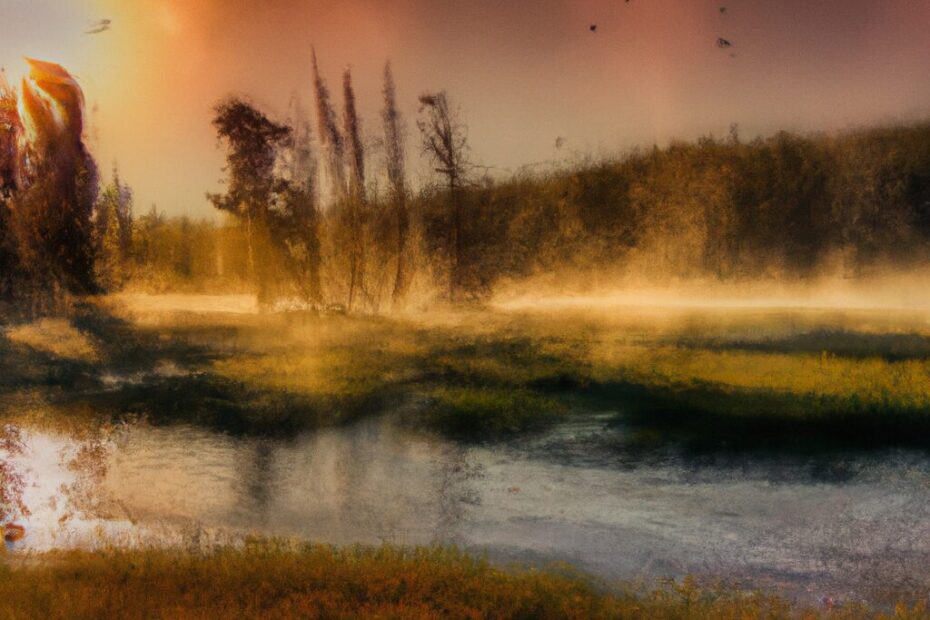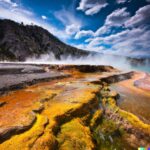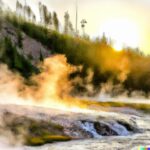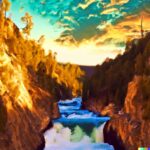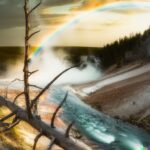Yellowstone National Park is home to some of the most stunning geothermal features in the world. From bubbling hot springs to the iconic Old Faithful geyser, the park offers a unique opportunity to witness the powerful forces of nature in action.
In this article, we will explore the geothermal wonders of Yellowstone National Park, including its volcanic activity, wildlife, and the importance of these natural wonders. We will also discuss how visitors can explore and experience these incredible features through guided tours, hiking trails, observation points, and educational programs.
So, let’s take a journey into the heart of Yellowstone’s geothermal wonders and discover the beauty and significance of these natural marvels.
What are Geothermal Wonders?
Geothermal wonders encompass natural phenomena created by the interaction of heat sources with geologic formations, resulting in unique landscapes and ecological significance.
Thermal pools, geysers, and hot springs are found all over the world, showcasing the Earth’s fascinating geological wonders. These formations occur when underground water meets hot rocks, resulting in steam and pressure that leads to eruptions of hot water and steam from the Earth’s crust.
The ecological significance of geothermal wonders lies in their ability to support diverse and unique ecosystems. These areas demonstrate the resilience of life in extreme conditions, making them valuable sites for scientific study and appreciation.
What is Yellowstone National Park?
Yellowstone National Park, located primarily in the U.S. state of Wyoming, is renowned for being a hub of geothermal wonders and a prime destination for tourists seeking unique ecological landscapes and geothermal exploration.
The park is home to the famous Old Faithful geyser, which erupts at regular intervals, captivating visitors with its impressive displays.
Visitors can marvel at the vibrant Grand Prismatic Spring, the largest hot spring in the United States, showcasing a stunning array of colors. As one explores the park, they can witness bubbling mud pots, fumaroles, and other geothermal features that make Yellowstone a geological marvel.
The opportunity for hiking, wildlife spotting, and camping amidst these unique natural phenomena further adds to the park’s allure for adventure enthusiasts.
What Makes Yellowstone National Park Unique?
Yellowstone National Park stands out due to its extraordinary volcanic activity, which has shaped its unique landscapes and endowed it with immense geothermal potential, making it a site of ecological and geological significance.
Location
The location of Yellowstone National Park provides access to abundant geothermal resources, making it an ideal ground for geothermal development and exploration initiatives.
The park’s unique proximity to the Yellowstone Caldera, one of the largest active volcanoes in the world, enhances its potential for tapping into the Earth’s natural heat.
The presence of geysers and hot springs within the park showcases the rich geothermal activity, offering opportunities for sustainable energy production and scientific research.
This natural abundance of geothermal resources presents an advantageous prospect for further sustainable and eco-friendly development within the park.
Volcanic Activity
The volcanic activity within Yellowstone Park fuels significant geothermal activity and contributes to complex geological processes, shaping the park’s distinct thermal features and landscapes.
As molten rock from the Earth’s mantle rises towards the surface, it heats underground water, creating geothermal features such as hot springs, geysers, and fumaroles.
This volcanic heat source maintains the high temperatures necessary for the existence of geothermal systems. The interaction between magma and water creates a dynamic environment that influences the movement of tectonic plates and the formation of various geological features in the region.
Geothermal Features
Yellowstone Park is renowned for its diverse thermal features, which are crucial to its ecological balance and conservation efforts, making it a hotspot for geothermal conservation and preservation.
The geothermal features found in the park, such as geysers, hot springs, mud pots, and fumaroles, are crucial for maintaining the delicate balance of the ecosystem. They offer specialized habitats for thermophilic organisms and play a key role in nutrient cycling processes.
These remarkable features attract visitors from all over the globe, highlighting the importance of geothermal conservation and the need to protect these rare natural wonders for future generations to enjoy.
Wildlife
The geothermal ecosystem of Yellowstone Park sustains a diverse array of wildlife, providing a unique habitat for numerous species and contributing to the preservation of biodiversity.
This intricate relationship between the geothermal features and wildlife creates a symbiotic balance wherein the thermal waters attract a variety of organisms, from bacteria and algae to larger mammals like bison and elk.
The hot springs and geysers act as natural hotspots, supporting unique microorganisms and providing warmth for animals during the harsh winters. The geothermal activity enriches the soil, leading to lush vegetation that sustains herbivores and, in turn, attracts predators, thereby creating a complex and interconnected web of life within the park.
What are the Geothermal Wonders in Yellowstone National Park?
The geothermal wonders of Yellowstone National Park encompass iconic features such as the Old Faithful Geyser, Grand Prismatic Spring, Mammoth Hot Springs, Norris Geyser Basin, and the Grand Canyon of the Yellowstone, each offering a distinct display of geothermal marvels.
These natural wonders showcase the power and beauty of geothermal activity. The Old Faithful Geyser, for example, is world-renowned for its predictable eruptions that reach heights of 100-180 feet.
The Grand Prismatic Spring, with its stunning rainbow-colored pools, is one of the largest hot springs in the world. Mammoth Hot Springs boasts terraces of travertine formations created by hot water flowing through limestone. Norris Geyser Basin is known for its dynamic and ever-changing geothermal features, while the Grand Canyon of the Yellowstone exhibits the dramatic results of volcanic activity and erosion over time.
Old Faithful Geyser
The Old Faithful Geyser stands as a symbol of geothermal exploration and discovery within Yellowstone Park, captivating visitors with its regular and impressive displays of natural power.
Old Faithful, one of the most famous geysers in the world, showcases mesmerizing eruptions that occur approximately every 90 minutes. These eruptions not only thrill spectators, but also provide significant insights into geothermal activity and contribute to scientific understanding of thermal processes.
For centuries, Old Faithful’s predictable performance has captivated onlookers and played a crucial role in advancing geothermal research. Its fame has also fueled interest in sustainable energy sources, as it highlights the immense energy stored beneath the Earth’s surface.
Grand Prismatic Spring
The Grand Prismatic Spring showcases the ongoing geothermal innovation and advancements in the understanding of thermal features, presenting a vivid display of natural artistry and geological marvels.
The Grand Prismatic Spring’s stunning display of vibrant colors is a sight to behold. The deep blue at its center transitions to vivid orange along the perimeter, mesmerizing visitors and serving as a testament to the complex interplay of microbial life and geothermal forces.
This unique combination of scientific significance and visual splendor has drawn researchers and tourists alike, sparking new avenues of exploration into the possibilities of harnessing geothermal energy for sustainable power generation and heating solutions. As one of the largest hot springs globally, its sheer magnitude and geological importance make it a critical focal point for understanding the earth’s dynamic processes and the potential applications of geothermal resources.
Mammoth Hot Springs
Mammoth Hot Springs exemplifies the essence of geothermal conservation and preservation, showcasing the intricate beauty and ecological significance of thermal formations within Yellowstone Park.
The geothermal features at Mammoth Hot Springs are not only a sight to behold but also play a crucial role in the conservation and preservation of the park’s unique ecosystem.
The hot springs provide a habitat for thermophiles, heat-loving microorganisms, that thrive in the extreme conditions created by the geothermal activity. By protecting and studying these organisms, researchers gain valuable insights into the potential for life in extreme environments, aiding in broader conservation efforts.
Norris Geyser Basin
The Norris Geyser Basin serves as a focal point for geothermal study and research, offering insights into the dynamic processes and geological wonders of Yellowstone’s thermal landscapes.
The Norris Geyser Basin is a popular destination for researchers due to its high concentration of geothermal features, including geysers, hot springs, and fumaroles. These features provide a unique opportunity to study the Earth’s energy sources. Additionally, the constantly changing hydrothermal features make it a fascinating area for researching microbial life in extreme environments.
The basin’s diverse mineral formations and hydrothermal alterations also make it a valuable natural laboratory for understanding geochemical processes beneath the Earth’s surface. As a result, it is an essential site for geothermal and geological research.
Grand Canyon of the Yellowstone
The Grand Canyon of the Yellowstone presents a remarkable canvas for geothermal education and tourism, offering visitors insight into the geological marvels and natural wonders shaped by geothermal forces.
Visitors are captivated by the vibrant hues of the canyon walls, which are adorned with colorful mineral deposits created by geothermal activity.
The unique geology of the canyon provides an ideal setting for educational programs focused on geothermal processes and their impact on the landscape. As visitors explore the canyon, they are not only immersed in its natural beauty but also gain a deeper understanding of geothermal features such as hot springs, fumaroles, and geysers.
This blend of education and awe-inspiring landscapes makes the Grand Canyon of the Yellowstone a must-visit destination for anyone interested in geothermal phenomena and the natural world.
Why are these Geothermal Wonders Important?
The geothermal wonders of Yellowstone National Park hold significance in facilitating scientific research, fostering tourism and recreation, and contributing to the conservation and preservation of valuable ecological and geological assets.
These natural marvels provide researchers with unique opportunities to study extreme environments and their potential implications for understanding Earth’s processes.
They attract visitors from around the world, generating economic benefits for the region and fostering appreciation for the natural world.
In terms of conservation, these geothermal features highlight the need to protect and manage delicate ecosystems, serving as a reminder of the interconnectedness between human activities and the environment.
Scientific Research
The geothermal wonders in Yellowstone Park offer a rich platform for scientific research, encompassing fields such as geothermal science, engineering, and the exploration of potential benefits derived from geothermal resources.
Exploring the geothermal features in Yellowstone provides a unique opportunity to study the Earth’s subsurface processes, heat transfer mechanisms, and sustainable energy solutions. Researchers can investigate the behavior of geothermal reservoirs, leading to advancements in understanding fluid flow, geochemistry, and the modeling of geothermal systems.
The park’s diverse geothermal manifestations also enable the study of extremophiles, microorganisms thriving in extreme environments, offering insight into astrobiology and the potential for life beyond Earth. These opportunities aid in fostering innovations for harnessing geothermal energy and understanding the planet’s geologic dynamics.
Tourism and Recreation
The geothermal wonders in Yellowstone Park attract visitors seeking unique and enriching experiences, fostering opportunities for geothermal tourism, adventure, and memorable visitor encounters with natural marvels.
The park’s geothermal features, including iconic geysers and colorful hot springs, create a captivating backdrop for hiking, wildlife observation, and outdoor exploration.
Nature enthusiasts can witness the power of nature in action, as the geothermal activity continuously shapes the landscape, offering a dynamic and ever-changing environment. The soothing hot springs provide a perfect setting for relaxation and rejuvenation, adding a wellness element to the overall visitor experience.
Conservation and Preservation
The geothermal wonders of Yellowstone Park play a vital role in conservation and preservation efforts, contributing to the protection of ecological balance, and the sustenance of valuable geothermal resources and natural environments.
Geothermal wonders are not just visually stunning, but also serve as vital habitats for unique microorganisms. Preserving these features is crucial to protect these specialized ecosystems and continue scientific research. Safeguarding these resources maintains natural balance and ensures a sustainable energy source for future generations.
How to Explore and Experience the Geothermal Wonders of Yellowstone National Park?
Exploring and experiencing the geothermal wonders of Yellowstone National Park can be achieved through guided tours, immersive hiking trails, and engaging educational programs, offering visitors diverse avenues for discovery and appreciation.
Guided tours provide fascinating insights into the park’s unique geothermal features, led by knowledgeable experts who share captivating stories and scientific knowledge.
The immersive hiking trails allow visitors to witness steaming geysers, bubbling mud pots, and vibrant hot springs up close, creating an unforgettable sensory experience. The park’s educational programs offer in-depth understanding of the geothermal processes, fostering a deeper appreciation for the park’s natural marvels.
Guided Tours
Guided tours offer opportunities for geothermal discovery, fostering awareness about the conservation and preservation efforts aimed at protecting the wonders of Yellowstone Park.
Visitors to the park can gain valuable insights into the geological features and processes responsible for its stunning geothermal phenomena, including geysers, hot springs, and mud pots. Knowledgeable guides lead tours that provide a deeper understanding of the delicate balance required to maintain these natural wonders.
These tours also emphasize the importance of responsible tourism, ensuring that visitors appreciate and respect the fragility of the geothermal areas while actively contributing to their preservation.
Hiking Trails
Hiking trails provide avenues for geothermal adventure, granting access to captivating landscapes and wildlife habitats shaped by the park’s geothermal forces and natural wonders.
The trails wind through otherworldly geothermal features, offering close-up encounters with bubbling mud pots, colorful hot springs, and steaming geysers. Hikers may stumble upon grazing bison, elusive elk, or the tracks of a wandering black bear, adding an element of excitement to the exploration.
These trails provide a unique opportunity to immerse oneself in the raw beauty and untamed wilderness, serving as a gateway to unforgettable experiences in the heart of nature.
Observation Points
Observation points offer opportunities for geothermal appreciation, granting insights into the diverse ecosystems and habitats sustained by the park’s geothermal influences and ecological marvels.
Visitors have the opportunity to witness the delicate balance between geological forces and the intricate web of life in unique environments. Bubbling hot springs and steam vents offer a glimpse into the dynamic relationship between geothermal activity and surrounding flora and fauna.
Through these observations, individuals can develop a deep appreciation for the interconnectedness of geology, ecology, and conservation efforts. This fosters a greater understanding of the importance of preserving these delicate ecosystems.
Educational Programs
Educational programs enrich the geothermal learning experiences for visitors, contributing to the depth of geothermal tourism and fostering memorable interactions with the park’s geothermal wonders.
These programs provide insightful opportunities for visitors to delve deeper into the scientific and environmental significance of geothermal activity.
By engaging in hands-on activities and interpretive sessions, participants gain a profound understanding of geothermal phenomena, enhancing their overall appreciation for the park’s natural resources.
These educational initiatives also empower individuals to become ambassadors for sustainable geothermal practices, ensuring that they leave with not just memories but also the knowledge and motivation to protect these unique natural wonders for future generations.
Frequently Asked Questions
What are the geothermal wonders of Yellowstone Park?
The geothermal wonders of Yellowstone Park refer to the many hot springs, geysers, mud pots, and other geothermal features located within the park.
Why are there so many geothermal wonders in Yellowstone Park?
Yellowstone Park sits on top of a supervolcano, which provides the heat necessary for these geothermal features to form and thrive.
What is the most famous geothermal wonder in Yellowstone Park?
The most famous geothermal wonder in Yellowstone Park is Old Faithful, a geyser that erupts regularly and consistently.
Are all of the geothermal features safe to visit?
While most of the geothermal features in Yellowstone Park are safe to visit, it is important to follow all warning signs and stay on designated paths to avoid accidental injury.
Can you swim in the geothermal features in Yellowstone Park?
Swimming in the geothermal features in Yellowstone Park is strictly prohibited. The water is extremely hot and can cause severe burns.
Are there any precautions to take when visiting the geothermal wonders of Yellowstone Park?
Yes, it is important to stay on designated paths and not touch or throw objects into the geothermal features. Also, be aware of the changing weather and always bring appropriate clothing and gear.
Last Updated on January 25, 2024 by Jon Waraas – Originally Posted: January 25, 2024

I’m Jon Waraas, and I’ve been navigating the online world since 2006. By day, I’m the proud owner of some eCommerce gems, and by night, I’m the voice behind the adventures on Waraas.Com.
My heart, however, belongs to the wild beauty of Yellowstone National Park. I’ve got a collection of websites dedicated to sharing the wonders of this natural masterpiece. Oh, and did I mention? I’m currently building my own cabin inside the ghost town of Gilmore, Idaho – a cabin with tales to tell!
When I’m not immersed in the digital realm, you’ll find me lacing up my boots for a good hike or setting up camp under the star-studded sky.
